Business Environment Report
VerifiedAdded on 2020/02/03
|12
|4185
|147
Report
AI Summary
This report analyzes Nestle's business environment, encompassing internal and external factors. It examines various organizational structures (sole proprietorship, partnership, corporation, franchising), identifying Nestle as a public limited company. The report delves into economic systems (traditional, command, market, mixed), highlighting Nestle's utilization of a mixed system. Fiscal and monetary policies, and their impact on Nestle's decision-making, are discussed. The influence of competition policies on product quality, pricing, and innovation is explored, along with an analysis of market structures (perfect competition, monopoly, monopolistic competition, oligopoly). The report also examines the impact of international trade on Nestle, considering both micro and macro factors (economic, technological, social). Finally, the report discusses the impact of European Union policies on Nestle's operations in the UK.
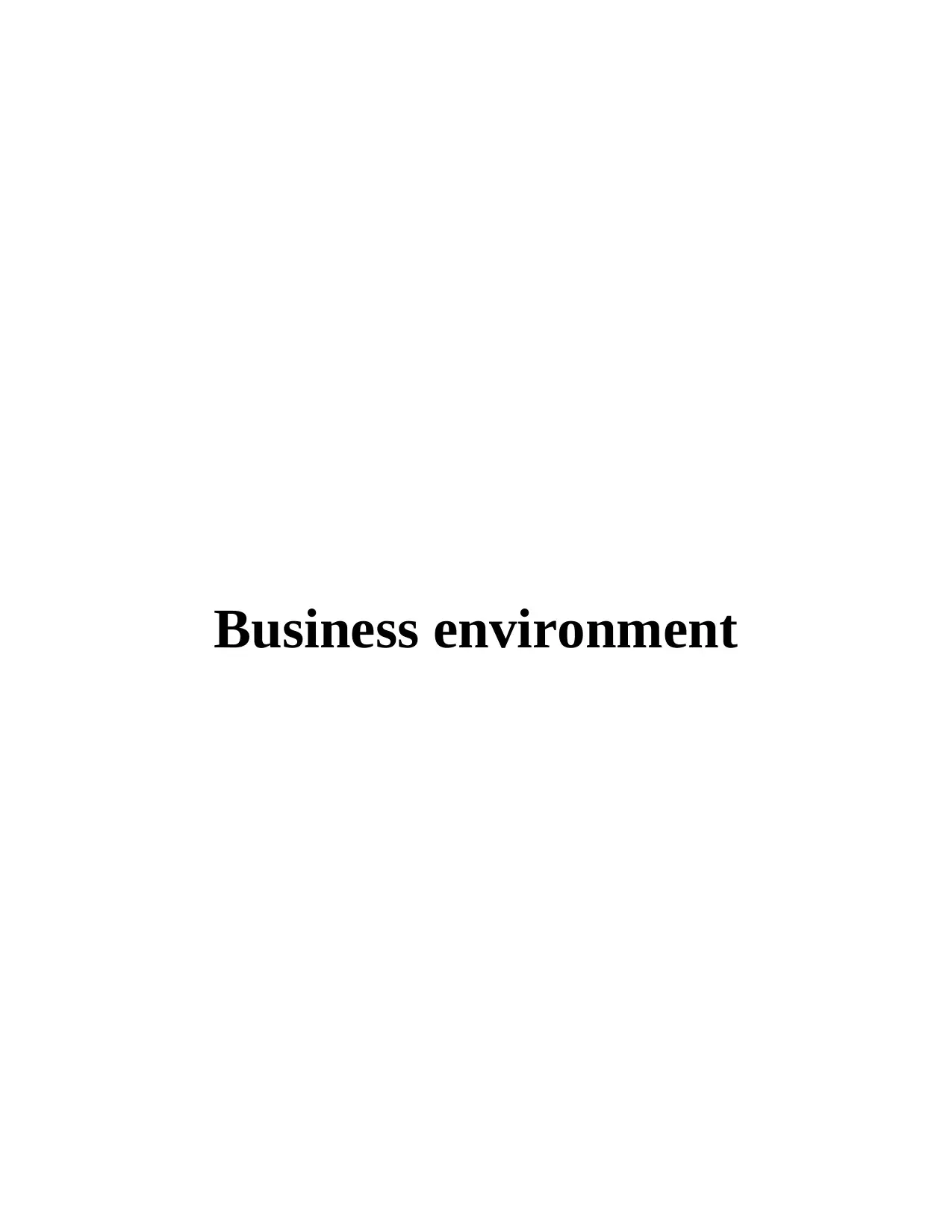
Business environment
Paraphrase This Document
Need a fresh take? Get an instant paraphrase of this document with our AI Paraphraser
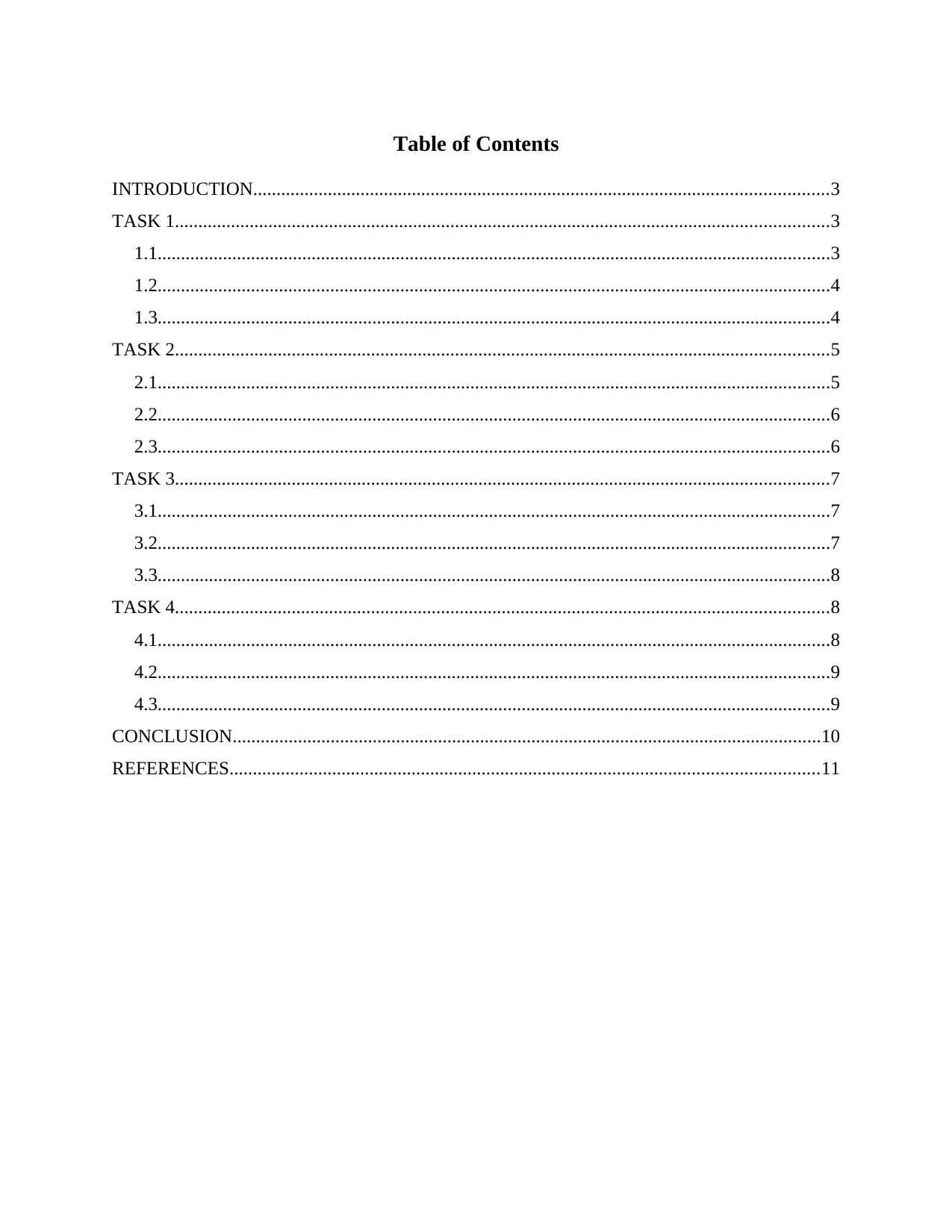
Table of Contents
INTRODUCTION...........................................................................................................................3
TASK 1............................................................................................................................................3
1.1................................................................................................................................................3
1.2................................................................................................................................................4
1.3................................................................................................................................................4
TASK 2............................................................................................................................................5
2.1................................................................................................................................................5
2.2................................................................................................................................................6
2.3................................................................................................................................................6
TASK 3............................................................................................................................................7
3.1................................................................................................................................................7
3.2................................................................................................................................................7
3.3................................................................................................................................................8
TASK 4............................................................................................................................................8
4.1................................................................................................................................................8
4.2................................................................................................................................................9
4.3................................................................................................................................................9
CONCLUSION..............................................................................................................................10
REFERENCES..............................................................................................................................11
INTRODUCTION...........................................................................................................................3
TASK 1............................................................................................................................................3
1.1................................................................................................................................................3
1.2................................................................................................................................................4
1.3................................................................................................................................................4
TASK 2............................................................................................................................................5
2.1................................................................................................................................................5
2.2................................................................................................................................................6
2.3................................................................................................................................................6
TASK 3............................................................................................................................................7
3.1................................................................................................................................................7
3.2................................................................................................................................................7
3.3................................................................................................................................................8
TASK 4............................................................................................................................................8
4.1................................................................................................................................................8
4.2................................................................................................................................................9
4.3................................................................................................................................................9
CONCLUSION..............................................................................................................................10
REFERENCES..............................................................................................................................11
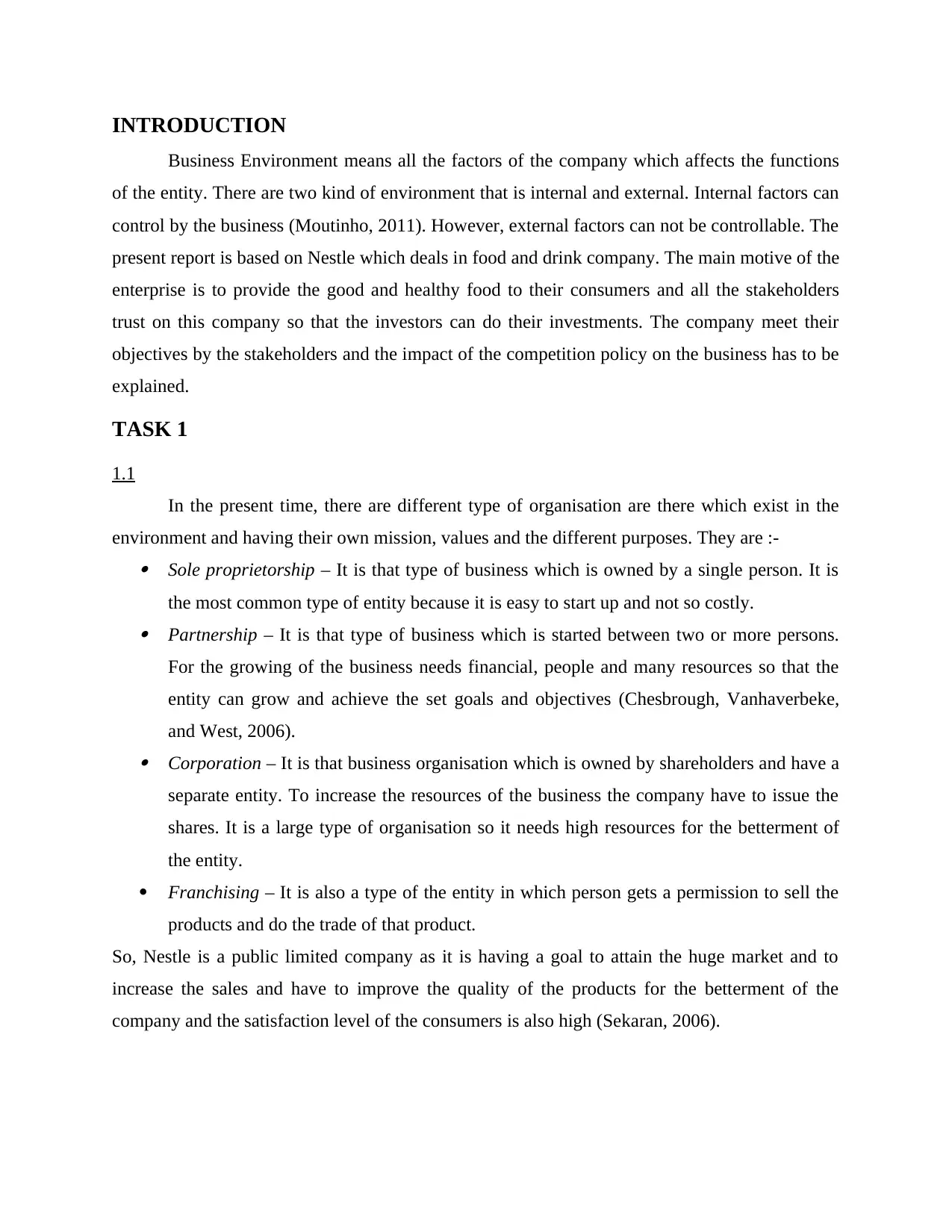
INTRODUCTION
Business Environment means all the factors of the company which affects the functions
of the entity. There are two kind of environment that is internal and external. Internal factors can
control by the business (Moutinho, 2011). However, external factors can not be controllable. The
present report is based on Nestle which deals in food and drink company. The main motive of the
enterprise is to provide the good and healthy food to their consumers and all the stakeholders
trust on this company so that the investors can do their investments. The company meet their
objectives by the stakeholders and the impact of the competition policy on the business has to be
explained.
TASK 1
1.1
In the present time, there are different type of organisation are there which exist in the
environment and having their own mission, values and the different purposes. They are :- Sole proprietorship – It is that type of business which is owned by a single person. It is
the most common type of entity because it is easy to start up and not so costly. Partnership – It is that type of business which is started between two or more persons.
For the growing of the business needs financial, people and many resources so that the
entity can grow and achieve the set goals and objectives (Chesbrough, Vanhaverbeke,
and West, 2006). Corporation – It is that business organisation which is owned by shareholders and have a
separate entity. To increase the resources of the business the company have to issue the
shares. It is a large type of organisation so it needs high resources for the betterment of
the entity.
Franchising – It is also a type of the entity in which person gets a permission to sell the
products and do the trade of that product.
So, Nestle is a public limited company as it is having a goal to attain the huge market and to
increase the sales and have to improve the quality of the products for the betterment of the
company and the satisfaction level of the consumers is also high (Sekaran, 2006).
Business Environment means all the factors of the company which affects the functions
of the entity. There are two kind of environment that is internal and external. Internal factors can
control by the business (Moutinho, 2011). However, external factors can not be controllable. The
present report is based on Nestle which deals in food and drink company. The main motive of the
enterprise is to provide the good and healthy food to their consumers and all the stakeholders
trust on this company so that the investors can do their investments. The company meet their
objectives by the stakeholders and the impact of the competition policy on the business has to be
explained.
TASK 1
1.1
In the present time, there are different type of organisation are there which exist in the
environment and having their own mission, values and the different purposes. They are :- Sole proprietorship – It is that type of business which is owned by a single person. It is
the most common type of entity because it is easy to start up and not so costly. Partnership – It is that type of business which is started between two or more persons.
For the growing of the business needs financial, people and many resources so that the
entity can grow and achieve the set goals and objectives (Chesbrough, Vanhaverbeke,
and West, 2006). Corporation – It is that business organisation which is owned by shareholders and have a
separate entity. To increase the resources of the business the company have to issue the
shares. It is a large type of organisation so it needs high resources for the betterment of
the entity.
Franchising – It is also a type of the entity in which person gets a permission to sell the
products and do the trade of that product.
So, Nestle is a public limited company as it is having a goal to attain the huge market and to
increase the sales and have to improve the quality of the products for the betterment of the
company and the satisfaction level of the consumers is also high (Sekaran, 2006).
⊘ This is a preview!⊘
Do you want full access?
Subscribe today to unlock all pages.

Trusted by 1+ million students worldwide
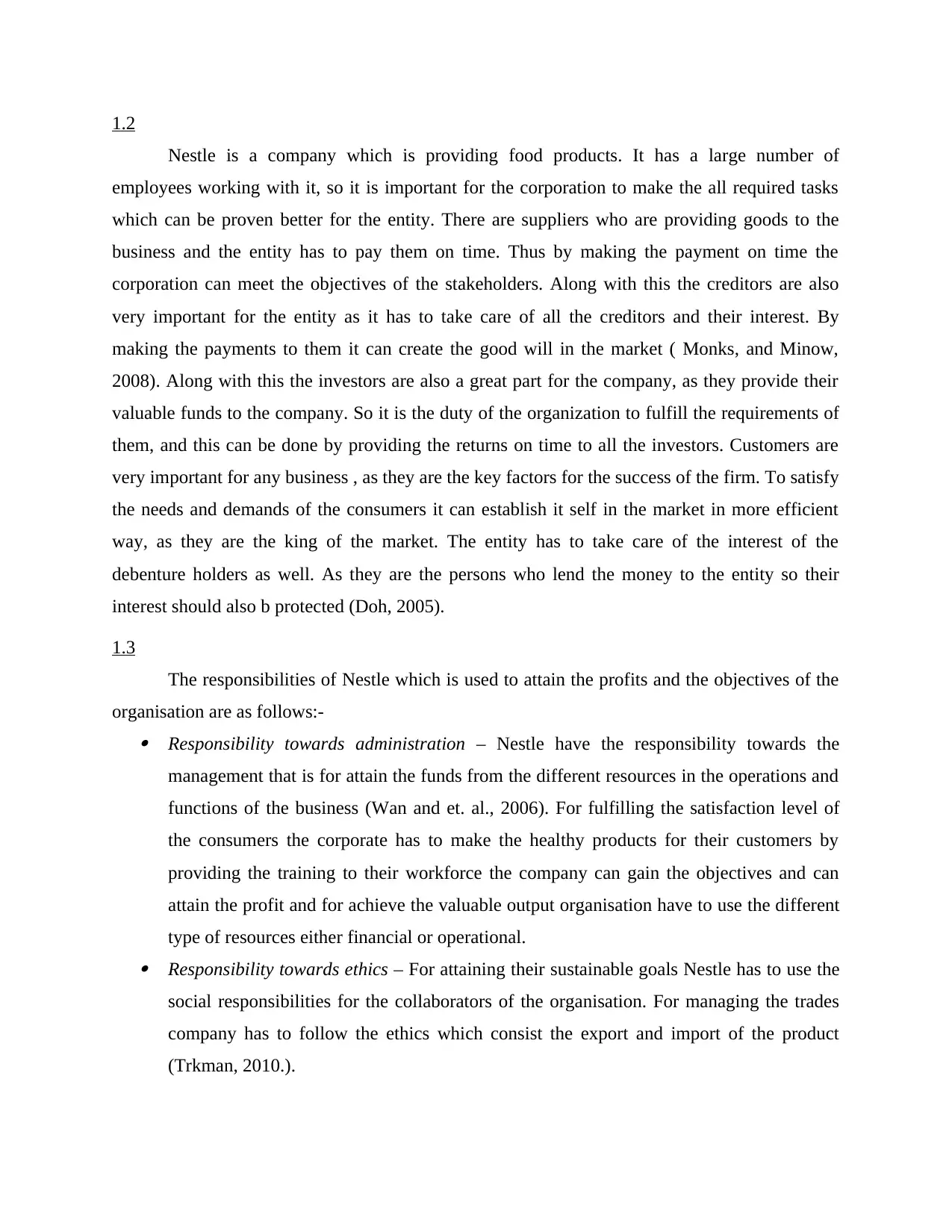
1.2
Nestle is a company which is providing food products. It has a large number of
employees working with it, so it is important for the corporation to make the all required tasks
which can be proven better for the entity. There are suppliers who are providing goods to the
business and the entity has to pay them on time. Thus by making the payment on time the
corporation can meet the objectives of the stakeholders. Along with this the creditors are also
very important for the entity as it has to take care of all the creditors and their interest. By
making the payments to them it can create the good will in the market ( Monks, and Minow,
2008). Along with this the investors are also a great part for the company, as they provide their
valuable funds to the company. So it is the duty of the organization to fulfill the requirements of
them, and this can be done by providing the returns on time to all the investors. Customers are
very important for any business , as they are the key factors for the success of the firm. To satisfy
the needs and demands of the consumers it can establish it self in the market in more efficient
way, as they are the king of the market. The entity has to take care of the interest of the
debenture holders as well. As they are the persons who lend the money to the entity so their
interest should also b protected (Doh, 2005).
1.3
The responsibilities of Nestle which is used to attain the profits and the objectives of the
organisation are as follows:- Responsibility towards administration – Nestle have the responsibility towards the
management that is for attain the funds from the different resources in the operations and
functions of the business (Wan and et. al., 2006). For fulfilling the satisfaction level of
the consumers the corporate has to make the healthy products for their customers by
providing the training to their workforce the company can gain the objectives and can
attain the profit and for achieve the valuable output organisation have to use the different
type of resources either financial or operational. Responsibility towards ethics – For attaining their sustainable goals Nestle has to use the
social responsibilities for the collaborators of the organisation. For managing the trades
company has to follow the ethics which consist the export and import of the product
(Trkman, 2010.).
Nestle is a company which is providing food products. It has a large number of
employees working with it, so it is important for the corporation to make the all required tasks
which can be proven better for the entity. There are suppliers who are providing goods to the
business and the entity has to pay them on time. Thus by making the payment on time the
corporation can meet the objectives of the stakeholders. Along with this the creditors are also
very important for the entity as it has to take care of all the creditors and their interest. By
making the payments to them it can create the good will in the market ( Monks, and Minow,
2008). Along with this the investors are also a great part for the company, as they provide their
valuable funds to the company. So it is the duty of the organization to fulfill the requirements of
them, and this can be done by providing the returns on time to all the investors. Customers are
very important for any business , as they are the key factors for the success of the firm. To satisfy
the needs and demands of the consumers it can establish it self in the market in more efficient
way, as they are the king of the market. The entity has to take care of the interest of the
debenture holders as well. As they are the persons who lend the money to the entity so their
interest should also b protected (Doh, 2005).
1.3
The responsibilities of Nestle which is used to attain the profits and the objectives of the
organisation are as follows:- Responsibility towards administration – Nestle have the responsibility towards the
management that is for attain the funds from the different resources in the operations and
functions of the business (Wan and et. al., 2006). For fulfilling the satisfaction level of
the consumers the corporate has to make the healthy products for their customers by
providing the training to their workforce the company can gain the objectives and can
attain the profit and for achieve the valuable output organisation have to use the different
type of resources either financial or operational. Responsibility towards ethics – For attaining their sustainable goals Nestle has to use the
social responsibilities for the collaborators of the organisation. For managing the trades
company has to follow the ethics which consist the export and import of the product
(Trkman, 2010.).
Paraphrase This Document
Need a fresh take? Get an instant paraphrase of this document with our AI Paraphraser
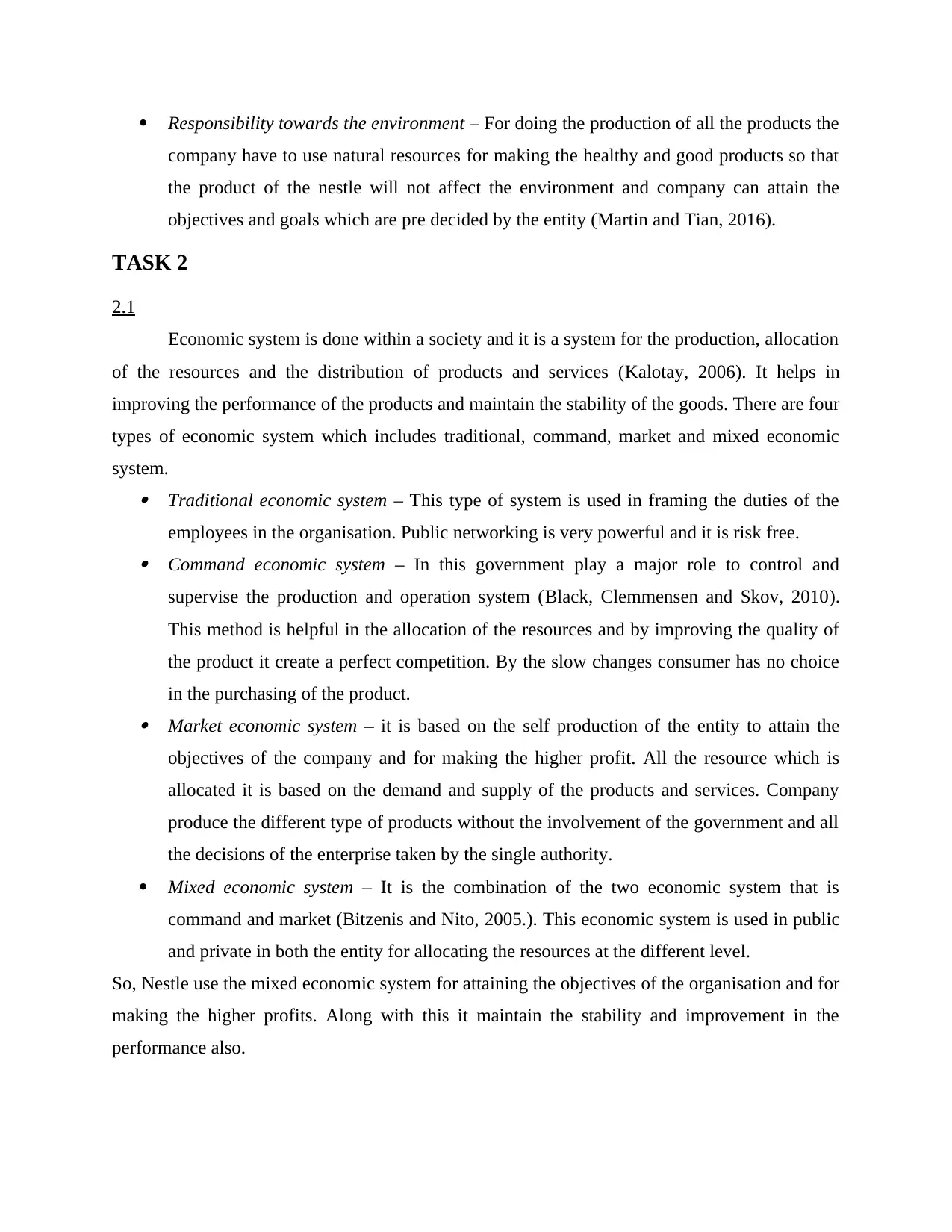
Responsibility towards the environment – For doing the production of all the products the
company have to use natural resources for making the healthy and good products so that
the product of the nestle will not affect the environment and company can attain the
objectives and goals which are pre decided by the entity (Martin and Tian, 2016).
TASK 2
2.1
Economic system is done within a society and it is a system for the production, allocation
of the resources and the distribution of products and services (Kalotay, 2006). It helps in
improving the performance of the products and maintain the stability of the goods. There are four
types of economic system which includes traditional, command, market and mixed economic
system. Traditional economic system – This type of system is used in framing the duties of the
employees in the organisation. Public networking is very powerful and it is risk free. Command economic system – In this government play a major role to control and
supervise the production and operation system (Black, Clemmensen and Skov, 2010).
This method is helpful in the allocation of the resources and by improving the quality of
the product it create a perfect competition. By the slow changes consumer has no choice
in the purchasing of the product. Market economic system – it is based on the self production of the entity to attain the
objectives of the company and for making the higher profit. All the resource which is
allocated it is based on the demand and supply of the products and services. Company
produce the different type of products without the involvement of the government and all
the decisions of the enterprise taken by the single authority.
Mixed economic system – It is the combination of the two economic system that is
command and market (Bitzenis and Nito, 2005.). This economic system is used in public
and private in both the entity for allocating the resources at the different level.
So, Nestle use the mixed economic system for attaining the objectives of the organisation and for
making the higher profits. Along with this it maintain the stability and improvement in the
performance also.
company have to use natural resources for making the healthy and good products so that
the product of the nestle will not affect the environment and company can attain the
objectives and goals which are pre decided by the entity (Martin and Tian, 2016).
TASK 2
2.1
Economic system is done within a society and it is a system for the production, allocation
of the resources and the distribution of products and services (Kalotay, 2006). It helps in
improving the performance of the products and maintain the stability of the goods. There are four
types of economic system which includes traditional, command, market and mixed economic
system. Traditional economic system – This type of system is used in framing the duties of the
employees in the organisation. Public networking is very powerful and it is risk free. Command economic system – In this government play a major role to control and
supervise the production and operation system (Black, Clemmensen and Skov, 2010).
This method is helpful in the allocation of the resources and by improving the quality of
the product it create a perfect competition. By the slow changes consumer has no choice
in the purchasing of the product. Market economic system – it is based on the self production of the entity to attain the
objectives of the company and for making the higher profit. All the resource which is
allocated it is based on the demand and supply of the products and services. Company
produce the different type of products without the involvement of the government and all
the decisions of the enterprise taken by the single authority.
Mixed economic system – It is the combination of the two economic system that is
command and market (Bitzenis and Nito, 2005.). This economic system is used in public
and private in both the entity for allocating the resources at the different level.
So, Nestle use the mixed economic system for attaining the objectives of the organisation and for
making the higher profits. Along with this it maintain the stability and improvement in the
performance also.
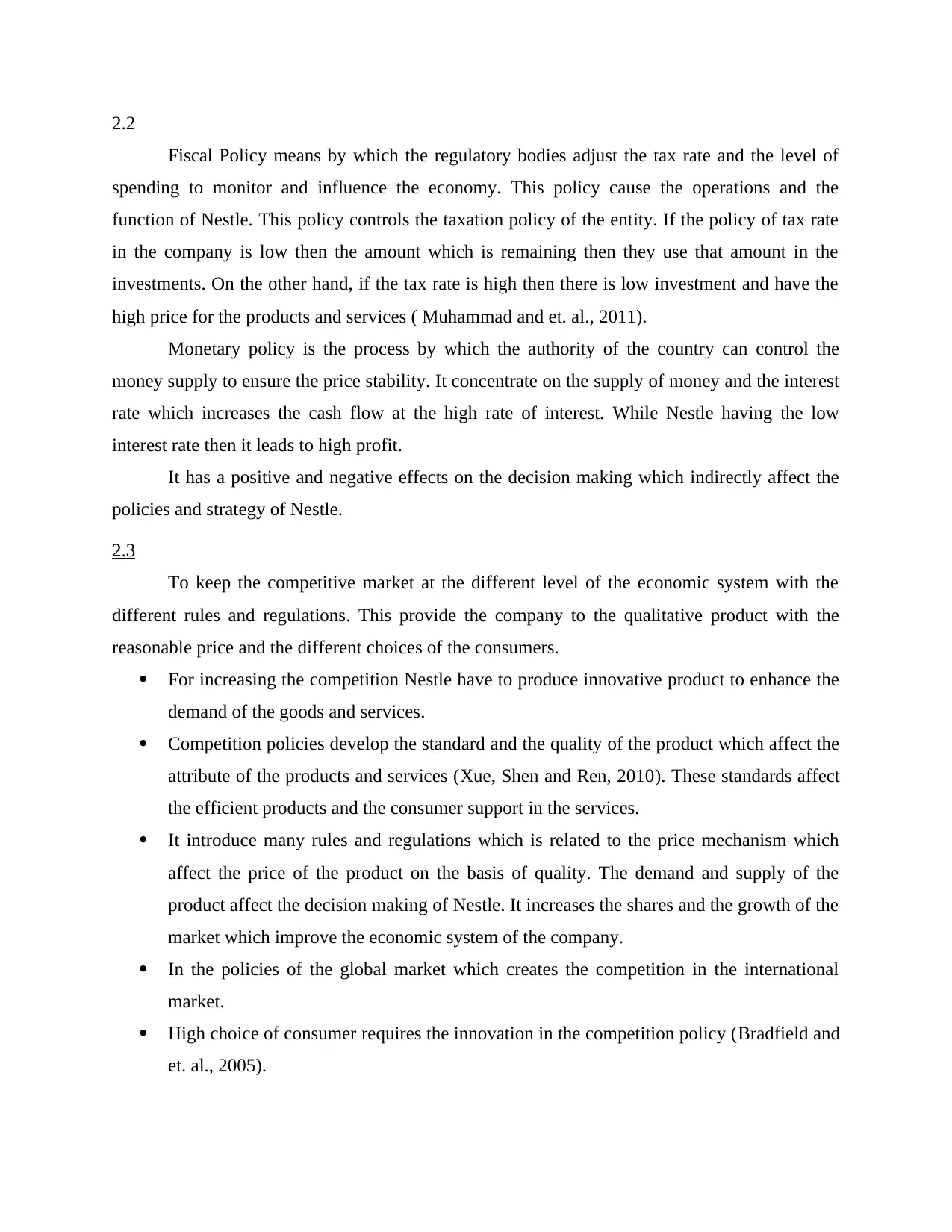
2.2
Fiscal Policy means by which the regulatory bodies adjust the tax rate and the level of
spending to monitor and influence the economy. This policy cause the operations and the
function of Nestle. This policy controls the taxation policy of the entity. If the policy of tax rate
in the company is low then the amount which is remaining then they use that amount in the
investments. On the other hand, if the tax rate is high then there is low investment and have the
high price for the products and services ( Muhammad and et. al., 2011).
Monetary policy is the process by which the authority of the country can control the
money supply to ensure the price stability. It concentrate on the supply of money and the interest
rate which increases the cash flow at the high rate of interest. While Nestle having the low
interest rate then it leads to high profit.
It has a positive and negative effects on the decision making which indirectly affect the
policies and strategy of Nestle.
2.3
To keep the competitive market at the different level of the economic system with the
different rules and regulations. This provide the company to the qualitative product with the
reasonable price and the different choices of the consumers.
For increasing the competition Nestle have to produce innovative product to enhance the
demand of the goods and services.
Competition policies develop the standard and the quality of the product which affect the
attribute of the products and services (Xue, Shen and Ren, 2010). These standards affect
the efficient products and the consumer support in the services.
It introduce many rules and regulations which is related to the price mechanism which
affect the price of the product on the basis of quality. The demand and supply of the
product affect the decision making of Nestle. It increases the shares and the growth of the
market which improve the economic system of the company.
In the policies of the global market which creates the competition in the international
market.
High choice of consumer requires the innovation in the competition policy (Bradfield and
et. al., 2005).
Fiscal Policy means by which the regulatory bodies adjust the tax rate and the level of
spending to monitor and influence the economy. This policy cause the operations and the
function of Nestle. This policy controls the taxation policy of the entity. If the policy of tax rate
in the company is low then the amount which is remaining then they use that amount in the
investments. On the other hand, if the tax rate is high then there is low investment and have the
high price for the products and services ( Muhammad and et. al., 2011).
Monetary policy is the process by which the authority of the country can control the
money supply to ensure the price stability. It concentrate on the supply of money and the interest
rate which increases the cash flow at the high rate of interest. While Nestle having the low
interest rate then it leads to high profit.
It has a positive and negative effects on the decision making which indirectly affect the
policies and strategy of Nestle.
2.3
To keep the competitive market at the different level of the economic system with the
different rules and regulations. This provide the company to the qualitative product with the
reasonable price and the different choices of the consumers.
For increasing the competition Nestle have to produce innovative product to enhance the
demand of the goods and services.
Competition policies develop the standard and the quality of the product which affect the
attribute of the products and services (Xue, Shen and Ren, 2010). These standards affect
the efficient products and the consumer support in the services.
It introduce many rules and regulations which is related to the price mechanism which
affect the price of the product on the basis of quality. The demand and supply of the
product affect the decision making of Nestle. It increases the shares and the growth of the
market which improve the economic system of the company.
In the policies of the global market which creates the competition in the international
market.
High choice of consumer requires the innovation in the competition policy (Bradfield and
et. al., 2005).
⊘ This is a preview!⊘
Do you want full access?
Subscribe today to unlock all pages.

Trusted by 1+ million students worldwide
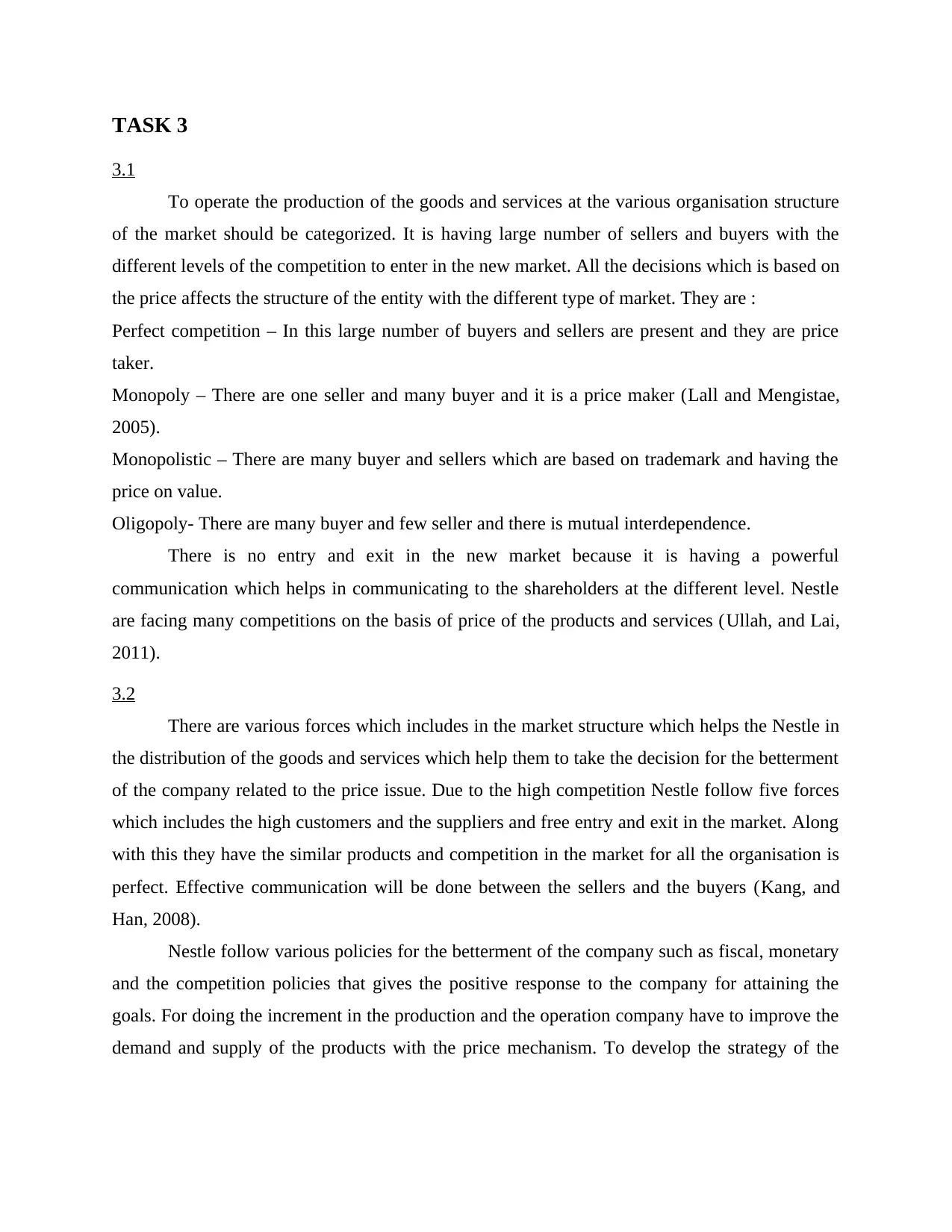
TASK 3
3.1
To operate the production of the goods and services at the various organisation structure
of the market should be categorized. It is having large number of sellers and buyers with the
different levels of the competition to enter in the new market. All the decisions which is based on
the price affects the structure of the entity with the different type of market. They are :
Perfect competition – In this large number of buyers and sellers are present and they are price
taker.
Monopoly – There are one seller and many buyer and it is a price maker (Lall and Mengistae,
2005).
Monopolistic – There are many buyer and sellers which are based on trademark and having the
price on value.
Oligopoly- There are many buyer and few seller and there is mutual interdependence.
There is no entry and exit in the new market because it is having a powerful
communication which helps in communicating to the shareholders at the different level. Nestle
are facing many competitions on the basis of price of the products and services (Ullah, and Lai,
2011).
3.2
There are various forces which includes in the market structure which helps the Nestle in
the distribution of the goods and services which help them to take the decision for the betterment
of the company related to the price issue. Due to the high competition Nestle follow five forces
which includes the high customers and the suppliers and free entry and exit in the market. Along
with this they have the similar products and competition in the market for all the organisation is
perfect. Effective communication will be done between the sellers and the buyers (Kang, and
Han, 2008).
Nestle follow various policies for the betterment of the company such as fiscal, monetary
and the competition policies that gives the positive response to the company for attaining the
goals. For doing the increment in the production and the operation company have to improve the
demand and supply of the products with the price mechanism. To develop the strategy of the
3.1
To operate the production of the goods and services at the various organisation structure
of the market should be categorized. It is having large number of sellers and buyers with the
different levels of the competition to enter in the new market. All the decisions which is based on
the price affects the structure of the entity with the different type of market. They are :
Perfect competition – In this large number of buyers and sellers are present and they are price
taker.
Monopoly – There are one seller and many buyer and it is a price maker (Lall and Mengistae,
2005).
Monopolistic – There are many buyer and sellers which are based on trademark and having the
price on value.
Oligopoly- There are many buyer and few seller and there is mutual interdependence.
There is no entry and exit in the new market because it is having a powerful
communication which helps in communicating to the shareholders at the different level. Nestle
are facing many competitions on the basis of price of the products and services (Ullah, and Lai,
2011).
3.2
There are various forces which includes in the market structure which helps the Nestle in
the distribution of the goods and services which help them to take the decision for the betterment
of the company related to the price issue. Due to the high competition Nestle follow five forces
which includes the high customers and the suppliers and free entry and exit in the market. Along
with this they have the similar products and competition in the market for all the organisation is
perfect. Effective communication will be done between the sellers and the buyers (Kang, and
Han, 2008).
Nestle follow various policies for the betterment of the company such as fiscal, monetary
and the competition policies that gives the positive response to the company for attaining the
goals. For doing the increment in the production and the operation company have to improve the
demand and supply of the products with the price mechanism. To develop the strategy of the
Paraphrase This Document
Need a fresh take? Get an instant paraphrase of this document with our AI Paraphraser
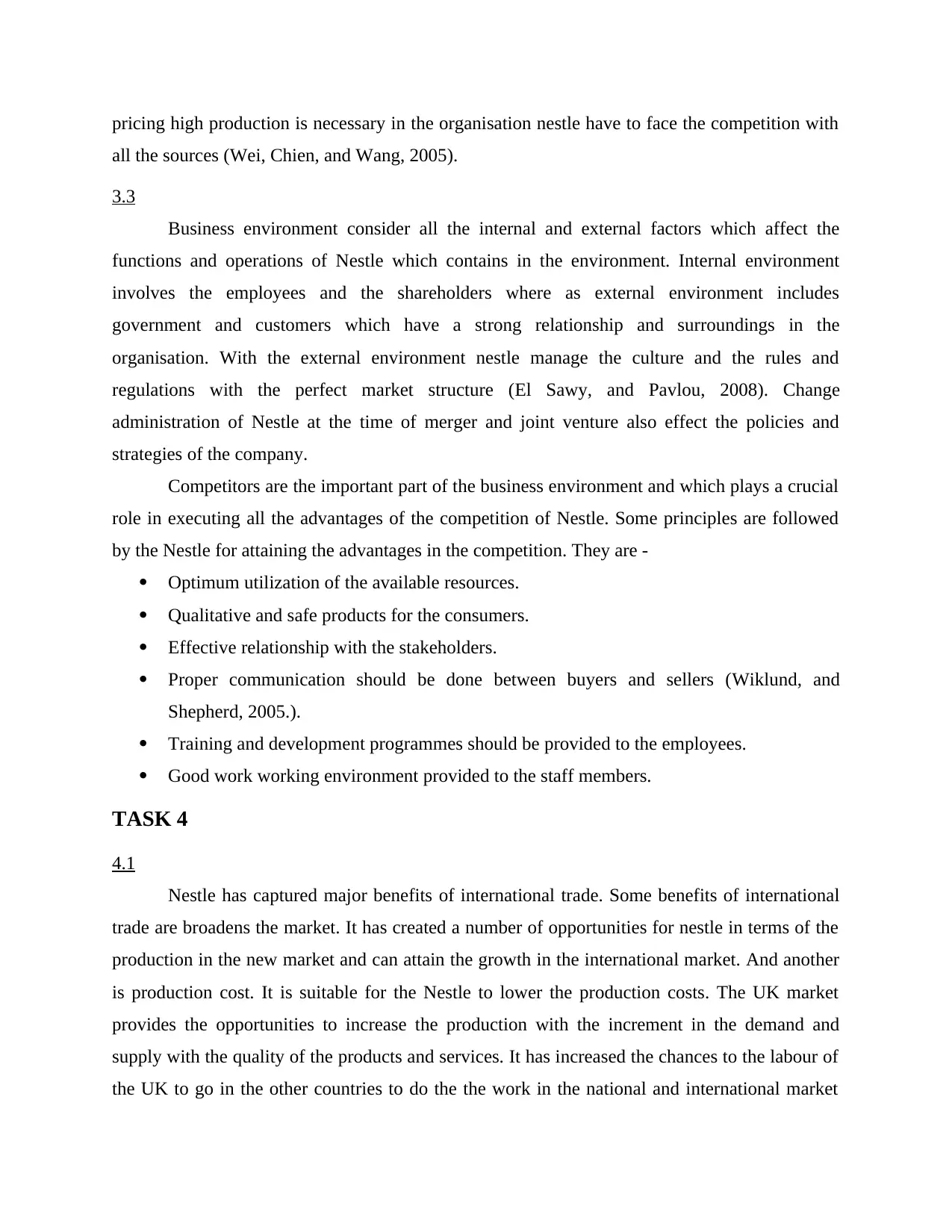
pricing high production is necessary in the organisation nestle have to face the competition with
all the sources (Wei, Chien, and Wang, 2005).
3.3
Business environment consider all the internal and external factors which affect the
functions and operations of Nestle which contains in the environment. Internal environment
involves the employees and the shareholders where as external environment includes
government and customers which have a strong relationship and surroundings in the
organisation. With the external environment nestle manage the culture and the rules and
regulations with the perfect market structure (El Sawy, and Pavlou, 2008). Change
administration of Nestle at the time of merger and joint venture also effect the policies and
strategies of the company.
Competitors are the important part of the business environment and which plays a crucial
role in executing all the advantages of the competition of Nestle. Some principles are followed
by the Nestle for attaining the advantages in the competition. They are -
Optimum utilization of the available resources.
Qualitative and safe products for the consumers.
Effective relationship with the stakeholders.
Proper communication should be done between buyers and sellers (Wiklund, and
Shepherd, 2005.).
Training and development programmes should be provided to the employees.
Good work working environment provided to the staff members.
TASK 4
4.1
Nestle has captured major benefits of international trade. Some benefits of international
trade are broadens the market. It has created a number of opportunities for nestle in terms of the
production in the new market and can attain the growth in the international market. And another
is production cost. It is suitable for the Nestle to lower the production costs. The UK market
provides the opportunities to increase the production with the increment in the demand and
supply with the quality of the products and services. It has increased the chances to the labour of
the UK to go in the other countries to do the the work in the national and international market
all the sources (Wei, Chien, and Wang, 2005).
3.3
Business environment consider all the internal and external factors which affect the
functions and operations of Nestle which contains in the environment. Internal environment
involves the employees and the shareholders where as external environment includes
government and customers which have a strong relationship and surroundings in the
organisation. With the external environment nestle manage the culture and the rules and
regulations with the perfect market structure (El Sawy, and Pavlou, 2008). Change
administration of Nestle at the time of merger and joint venture also effect the policies and
strategies of the company.
Competitors are the important part of the business environment and which plays a crucial
role in executing all the advantages of the competition of Nestle. Some principles are followed
by the Nestle for attaining the advantages in the competition. They are -
Optimum utilization of the available resources.
Qualitative and safe products for the consumers.
Effective relationship with the stakeholders.
Proper communication should be done between buyers and sellers (Wiklund, and
Shepherd, 2005.).
Training and development programmes should be provided to the employees.
Good work working environment provided to the staff members.
TASK 4
4.1
Nestle has captured major benefits of international trade. Some benefits of international
trade are broadens the market. It has created a number of opportunities for nestle in terms of the
production in the new market and can attain the growth in the international market. And another
is production cost. It is suitable for the Nestle to lower the production costs. The UK market
provides the opportunities to increase the production with the increment in the demand and
supply with the quality of the products and services. It has increased the chances to the labour of
the UK to go in the other countries to do the the work in the national and international market
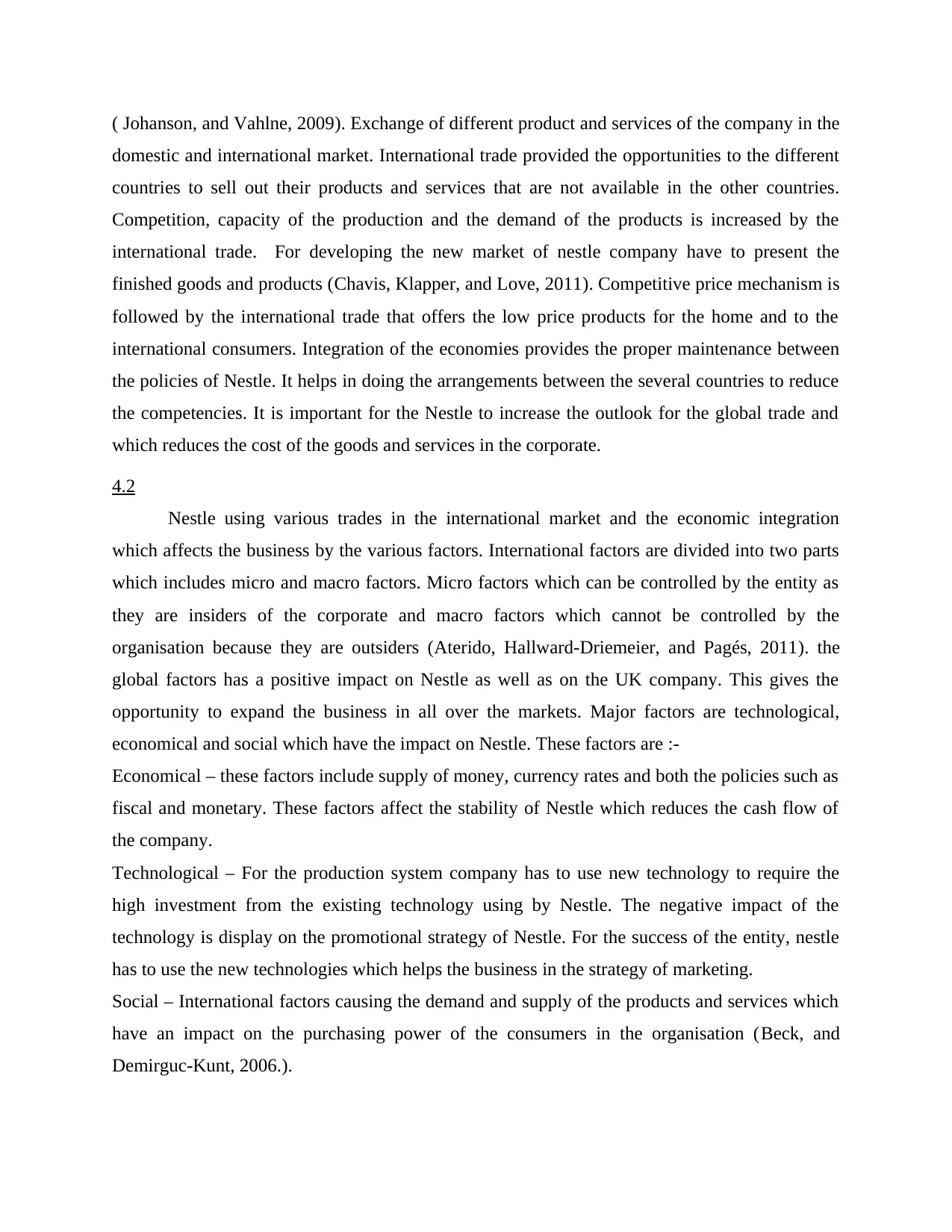
( Johanson, and Vahlne, 2009). Exchange of different product and services of the company in the
domestic and international market. International trade provided the opportunities to the different
countries to sell out their products and services that are not available in the other countries.
Competition, capacity of the production and the demand of the products is increased by the
international trade. For developing the new market of nestle company have to present the
finished goods and products (Chavis, Klapper, and Love, 2011). Competitive price mechanism is
followed by the international trade that offers the low price products for the home and to the
international consumers. Integration of the economies provides the proper maintenance between
the policies of Nestle. It helps in doing the arrangements between the several countries to reduce
the competencies. It is important for the Nestle to increase the outlook for the global trade and
which reduces the cost of the goods and services in the corporate.
4.2
Nestle using various trades in the international market and the economic integration
which affects the business by the various factors. International factors are divided into two parts
which includes micro and macro factors. Micro factors which can be controlled by the entity as
they are insiders of the corporate and macro factors which cannot be controlled by the
organisation because they are outsiders (Aterido, Hallward-Driemeier, and Pagés, 2011). the
global factors has a positive impact on Nestle as well as on the UK company. This gives the
opportunity to expand the business in all over the markets. Major factors are technological,
economical and social which have the impact on Nestle. These factors are :-
Economical – these factors include supply of money, currency rates and both the policies such as
fiscal and monetary. These factors affect the stability of Nestle which reduces the cash flow of
the company.
Technological – For the production system company has to use new technology to require the
high investment from the existing technology using by Nestle. The negative impact of the
technology is display on the promotional strategy of Nestle. For the success of the entity, nestle
has to use the new technologies which helps the business in the strategy of marketing.
Social – International factors causing the demand and supply of the products and services which
have an impact on the purchasing power of the consumers in the organisation (Beck, and
Demirguc-Kunt, 2006.).
domestic and international market. International trade provided the opportunities to the different
countries to sell out their products and services that are not available in the other countries.
Competition, capacity of the production and the demand of the products is increased by the
international trade. For developing the new market of nestle company have to present the
finished goods and products (Chavis, Klapper, and Love, 2011). Competitive price mechanism is
followed by the international trade that offers the low price products for the home and to the
international consumers. Integration of the economies provides the proper maintenance between
the policies of Nestle. It helps in doing the arrangements between the several countries to reduce
the competencies. It is important for the Nestle to increase the outlook for the global trade and
which reduces the cost of the goods and services in the corporate.
4.2
Nestle using various trades in the international market and the economic integration
which affects the business by the various factors. International factors are divided into two parts
which includes micro and macro factors. Micro factors which can be controlled by the entity as
they are insiders of the corporate and macro factors which cannot be controlled by the
organisation because they are outsiders (Aterido, Hallward-Driemeier, and Pagés, 2011). the
global factors has a positive impact on Nestle as well as on the UK company. This gives the
opportunity to expand the business in all over the markets. Major factors are technological,
economical and social which have the impact on Nestle. These factors are :-
Economical – these factors include supply of money, currency rates and both the policies such as
fiscal and monetary. These factors affect the stability of Nestle which reduces the cash flow of
the company.
Technological – For the production system company has to use new technology to require the
high investment from the existing technology using by Nestle. The negative impact of the
technology is display on the promotional strategy of Nestle. For the success of the entity, nestle
has to use the new technologies which helps the business in the strategy of marketing.
Social – International factors causing the demand and supply of the products and services which
have an impact on the purchasing power of the consumers in the organisation (Beck, and
Demirguc-Kunt, 2006.).
⊘ This is a preview!⊘
Do you want full access?
Subscribe today to unlock all pages.

Trusted by 1+ million students worldwide
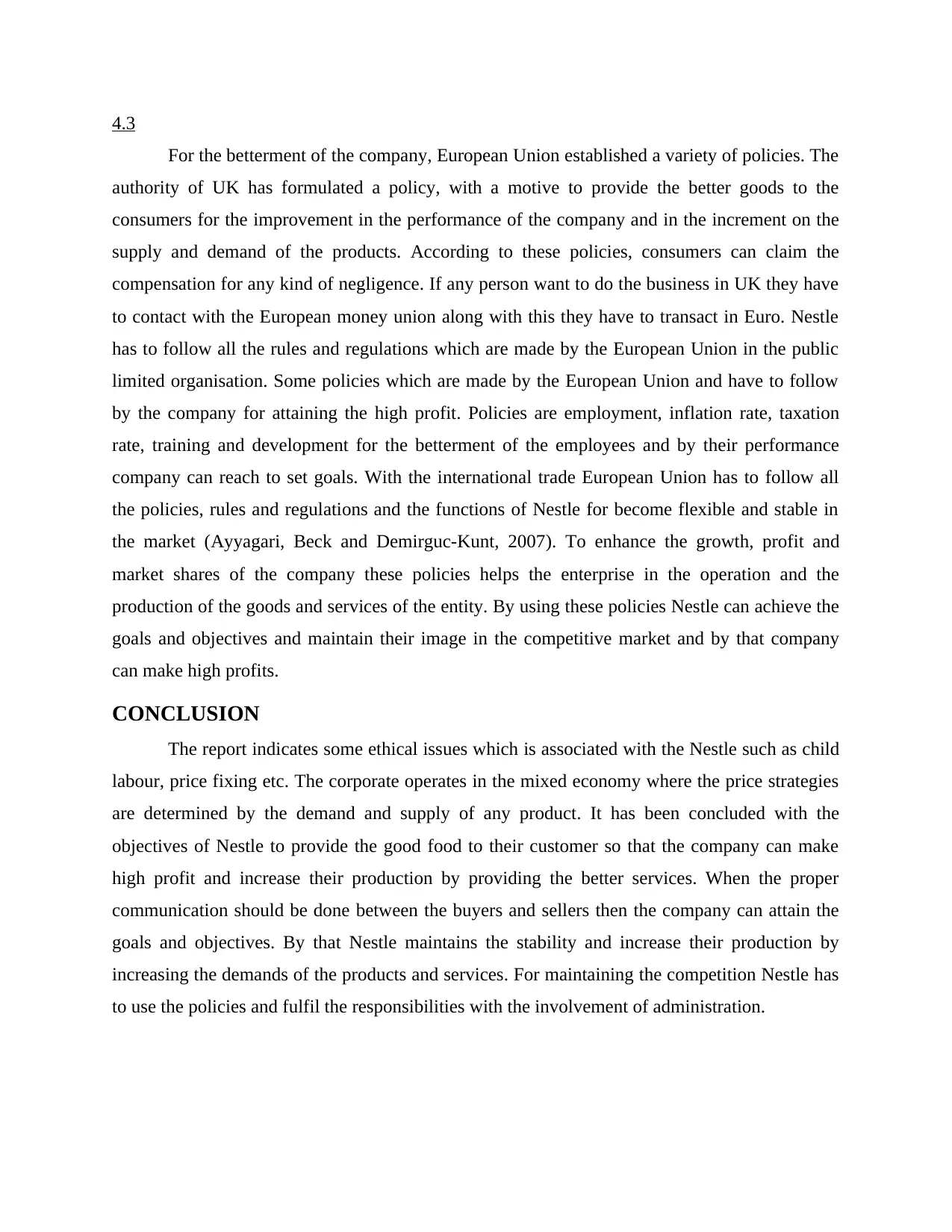
4.3
For the betterment of the company, European Union established a variety of policies. The
authority of UK has formulated a policy, with a motive to provide the better goods to the
consumers for the improvement in the performance of the company and in the increment on the
supply and demand of the products. According to these policies, consumers can claim the
compensation for any kind of negligence. If any person want to do the business in UK they have
to contact with the European money union along with this they have to transact in Euro. Nestle
has to follow all the rules and regulations which are made by the European Union in the public
limited organisation. Some policies which are made by the European Union and have to follow
by the company for attaining the high profit. Policies are employment, inflation rate, taxation
rate, training and development for the betterment of the employees and by their performance
company can reach to set goals. With the international trade European Union has to follow all
the policies, rules and regulations and the functions of Nestle for become flexible and stable in
the market (Ayyagari, Beck and Demirguc-Kunt, 2007). To enhance the growth, profit and
market shares of the company these policies helps the enterprise in the operation and the
production of the goods and services of the entity. By using these policies Nestle can achieve the
goals and objectives and maintain their image in the competitive market and by that company
can make high profits.
CONCLUSION
The report indicates some ethical issues which is associated with the Nestle such as child
labour, price fixing etc. The corporate operates in the mixed economy where the price strategies
are determined by the demand and supply of any product. It has been concluded with the
objectives of Nestle to provide the good food to their customer so that the company can make
high profit and increase their production by providing the better services. When the proper
communication should be done between the buyers and sellers then the company can attain the
goals and objectives. By that Nestle maintains the stability and increase their production by
increasing the demands of the products and services. For maintaining the competition Nestle has
to use the policies and fulfil the responsibilities with the involvement of administration.
For the betterment of the company, European Union established a variety of policies. The
authority of UK has formulated a policy, with a motive to provide the better goods to the
consumers for the improvement in the performance of the company and in the increment on the
supply and demand of the products. According to these policies, consumers can claim the
compensation for any kind of negligence. If any person want to do the business in UK they have
to contact with the European money union along with this they have to transact in Euro. Nestle
has to follow all the rules and regulations which are made by the European Union in the public
limited organisation. Some policies which are made by the European Union and have to follow
by the company for attaining the high profit. Policies are employment, inflation rate, taxation
rate, training and development for the betterment of the employees and by their performance
company can reach to set goals. With the international trade European Union has to follow all
the policies, rules and regulations and the functions of Nestle for become flexible and stable in
the market (Ayyagari, Beck and Demirguc-Kunt, 2007). To enhance the growth, profit and
market shares of the company these policies helps the enterprise in the operation and the
production of the goods and services of the entity. By using these policies Nestle can achieve the
goals and objectives and maintain their image in the competitive market and by that company
can make high profits.
CONCLUSION
The report indicates some ethical issues which is associated with the Nestle such as child
labour, price fixing etc. The corporate operates in the mixed economy where the price strategies
are determined by the demand and supply of any product. It has been concluded with the
objectives of Nestle to provide the good food to their customer so that the company can make
high profit and increase their production by providing the better services. When the proper
communication should be done between the buyers and sellers then the company can attain the
goals and objectives. By that Nestle maintains the stability and increase their production by
increasing the demands of the products and services. For maintaining the competition Nestle has
to use the policies and fulfil the responsibilities with the involvement of administration.
Paraphrase This Document
Need a fresh take? Get an instant paraphrase of this document with our AI Paraphraser
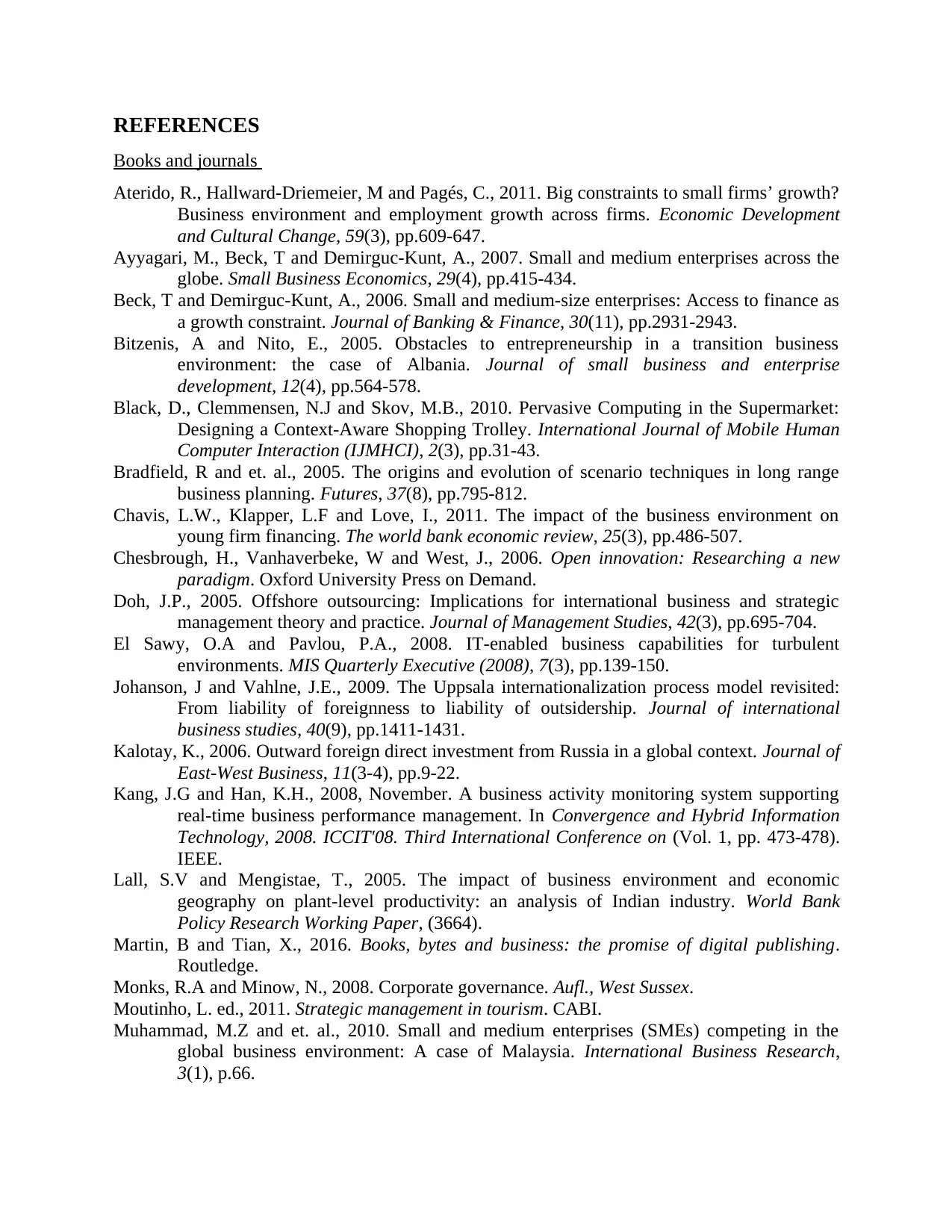
REFERENCES
Books and journals
Aterido, R., Hallward-Driemeier, M and Pagés, C., 2011. Big constraints to small firms’ growth?
Business environment and employment growth across firms. Economic Development
and Cultural Change, 59(3), pp.609-647.
Ayyagari, M., Beck, T and Demirguc-Kunt, A., 2007. Small and medium enterprises across the
globe. Small Business Economics, 29(4), pp.415-434.
Beck, T and Demirguc-Kunt, A., 2006. Small and medium-size enterprises: Access to finance as
a growth constraint. Journal of Banking & Finance, 30(11), pp.2931-2943.
Bitzenis, A and Nito, E., 2005. Obstacles to entrepreneurship in a transition business
environment: the case of Albania. Journal of small business and enterprise
development, 12(4), pp.564-578.
Black, D., Clemmensen, N.J and Skov, M.B., 2010. Pervasive Computing in the Supermarket:
Designing a Context-Aware Shopping Trolley. International Journal of Mobile Human
Computer Interaction (IJMHCI), 2(3), pp.31-43.
Bradfield, R and et. al., 2005. The origins and evolution of scenario techniques in long range
business planning. Futures, 37(8), pp.795-812.
Chavis, L.W., Klapper, L.F and Love, I., 2011. The impact of the business environment on
young firm financing. The world bank economic review, 25(3), pp.486-507.
Chesbrough, H., Vanhaverbeke, W and West, J., 2006. Open innovation: Researching a new
paradigm. Oxford University Press on Demand.
Doh, J.P., 2005. Offshore outsourcing: Implications for international business and strategic
management theory and practice. Journal of Management Studies, 42(3), pp.695-704.
El Sawy, O.A and Pavlou, P.A., 2008. IT-enabled business capabilities for turbulent
environments. MIS Quarterly Executive (2008), 7(3), pp.139-150.
Johanson, J and Vahlne, J.E., 2009. The Uppsala internationalization process model revisited:
From liability of foreignness to liability of outsidership. Journal of international
business studies, 40(9), pp.1411-1431.
Kalotay, K., 2006. Outward foreign direct investment from Russia in a global context. Journal of
East-West Business, 11(3-4), pp.9-22.
Kang, J.G and Han, K.H., 2008, November. A business activity monitoring system supporting
real-time business performance management. In Convergence and Hybrid Information
Technology, 2008. ICCIT'08. Third International Conference on (Vol. 1, pp. 473-478).
IEEE.
Lall, S.V and Mengistae, T., 2005. The impact of business environment and economic
geography on plant-level productivity: an analysis of Indian industry. World Bank
Policy Research Working Paper, (3664).
Martin, B and Tian, X., 2016. Books, bytes and business: the promise of digital publishing.
Routledge.
Monks, R.A and Minow, N., 2008. Corporate governance. Aufl., West Sussex.
Moutinho, L. ed., 2011. Strategic management in tourism. CABI.
Muhammad, M.Z and et. al., 2010. Small and medium enterprises (SMEs) competing in the
global business environment: A case of Malaysia. International Business Research,
3(1), p.66.
Books and journals
Aterido, R., Hallward-Driemeier, M and Pagés, C., 2011. Big constraints to small firms’ growth?
Business environment and employment growth across firms. Economic Development
and Cultural Change, 59(3), pp.609-647.
Ayyagari, M., Beck, T and Demirguc-Kunt, A., 2007. Small and medium enterprises across the
globe. Small Business Economics, 29(4), pp.415-434.
Beck, T and Demirguc-Kunt, A., 2006. Small and medium-size enterprises: Access to finance as
a growth constraint. Journal of Banking & Finance, 30(11), pp.2931-2943.
Bitzenis, A and Nito, E., 2005. Obstacles to entrepreneurship in a transition business
environment: the case of Albania. Journal of small business and enterprise
development, 12(4), pp.564-578.
Black, D., Clemmensen, N.J and Skov, M.B., 2010. Pervasive Computing in the Supermarket:
Designing a Context-Aware Shopping Trolley. International Journal of Mobile Human
Computer Interaction (IJMHCI), 2(3), pp.31-43.
Bradfield, R and et. al., 2005. The origins and evolution of scenario techniques in long range
business planning. Futures, 37(8), pp.795-812.
Chavis, L.W., Klapper, L.F and Love, I., 2011. The impact of the business environment on
young firm financing. The world bank economic review, 25(3), pp.486-507.
Chesbrough, H., Vanhaverbeke, W and West, J., 2006. Open innovation: Researching a new
paradigm. Oxford University Press on Demand.
Doh, J.P., 2005. Offshore outsourcing: Implications for international business and strategic
management theory and practice. Journal of Management Studies, 42(3), pp.695-704.
El Sawy, O.A and Pavlou, P.A., 2008. IT-enabled business capabilities for turbulent
environments. MIS Quarterly Executive (2008), 7(3), pp.139-150.
Johanson, J and Vahlne, J.E., 2009. The Uppsala internationalization process model revisited:
From liability of foreignness to liability of outsidership. Journal of international
business studies, 40(9), pp.1411-1431.
Kalotay, K., 2006. Outward foreign direct investment from Russia in a global context. Journal of
East-West Business, 11(3-4), pp.9-22.
Kang, J.G and Han, K.H., 2008, November. A business activity monitoring system supporting
real-time business performance management. In Convergence and Hybrid Information
Technology, 2008. ICCIT'08. Third International Conference on (Vol. 1, pp. 473-478).
IEEE.
Lall, S.V and Mengistae, T., 2005. The impact of business environment and economic
geography on plant-level productivity: an analysis of Indian industry. World Bank
Policy Research Working Paper, (3664).
Martin, B and Tian, X., 2016. Books, bytes and business: the promise of digital publishing.
Routledge.
Monks, R.A and Minow, N., 2008. Corporate governance. Aufl., West Sussex.
Moutinho, L. ed., 2011. Strategic management in tourism. CABI.
Muhammad, M.Z and et. al., 2010. Small and medium enterprises (SMEs) competing in the
global business environment: A case of Malaysia. International Business Research,
3(1), p.66.
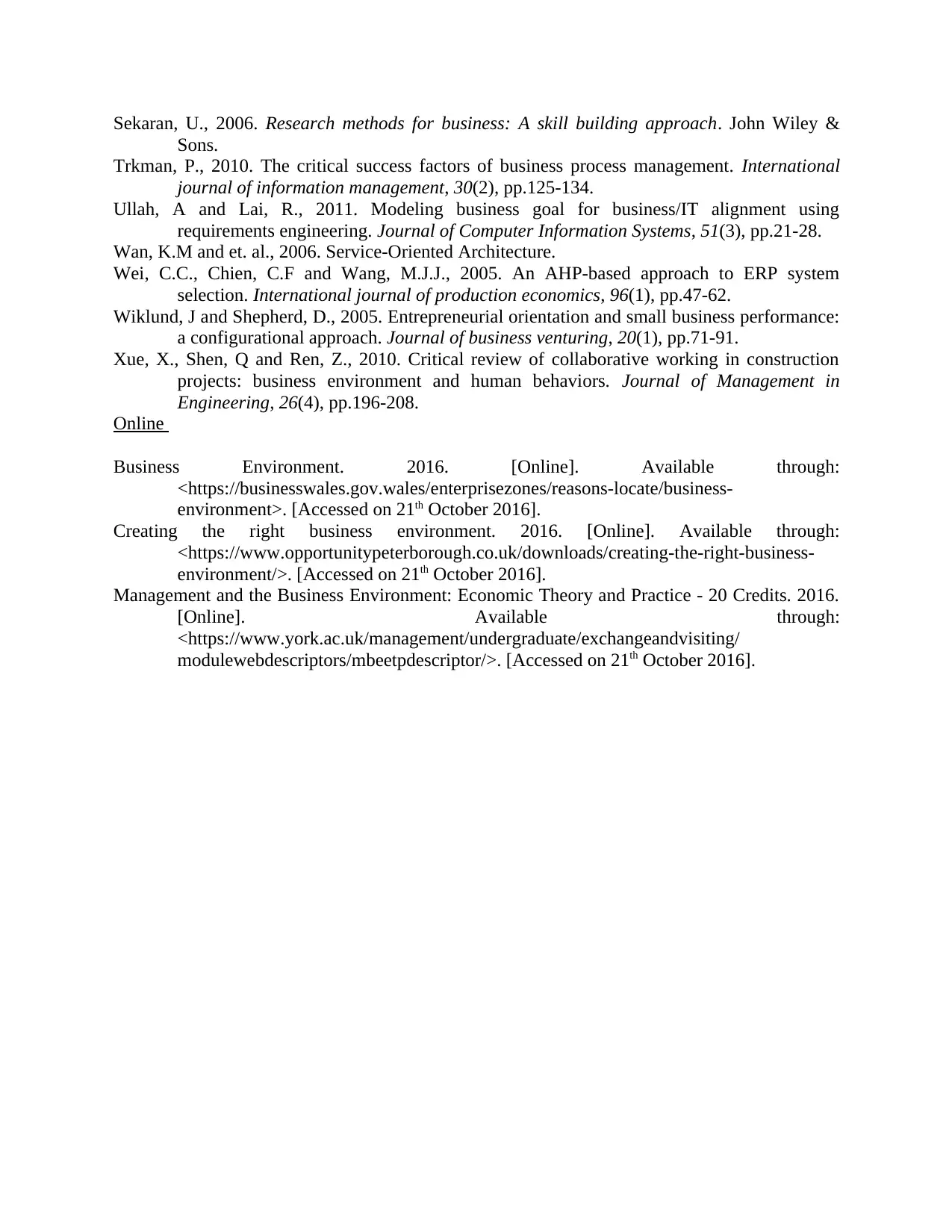
Sekaran, U., 2006. Research methods for business: A skill building approach. John Wiley &
Sons.
Trkman, P., 2010. The critical success factors of business process management. International
journal of information management, 30(2), pp.125-134.
Ullah, A and Lai, R., 2011. Modeling business goal for business/IT alignment using
requirements engineering. Journal of Computer Information Systems, 51(3), pp.21-28.
Wan, K.M and et. al., 2006. Service-Oriented Architecture.
Wei, C.C., Chien, C.F and Wang, M.J.J., 2005. An AHP-based approach to ERP system
selection. International journal of production economics, 96(1), pp.47-62.
Wiklund, J and Shepherd, D., 2005. Entrepreneurial orientation and small business performance:
a configurational approach. Journal of business venturing, 20(1), pp.71-91.
Xue, X., Shen, Q and Ren, Z., 2010. Critical review of collaborative working in construction
projects: business environment and human behaviors. Journal of Management in
Engineering, 26(4), pp.196-208.
Online
Business Environment. 2016. [Online]. Available through:
<https://businesswales.gov.wales/enterprisezones/reasons-locate/business-
environment>. [Accessed on 21th October 2016].
Creating the right business environment. 2016. [Online]. Available through:
<https://www.opportunitypeterborough.co.uk/downloads/creating-the-right-business-
environment/>. [Accessed on 21th October 2016].
Management and the Business Environment: Economic Theory and Practice - 20 Credits. 2016.
[Online]. Available through:
<https://www.york.ac.uk/management/undergraduate/exchangeandvisiting/
modulewebdescriptors/mbeetpdescriptor/>. [Accessed on 21th October 2016].
Sons.
Trkman, P., 2010. The critical success factors of business process management. International
journal of information management, 30(2), pp.125-134.
Ullah, A and Lai, R., 2011. Modeling business goal for business/IT alignment using
requirements engineering. Journal of Computer Information Systems, 51(3), pp.21-28.
Wan, K.M and et. al., 2006. Service-Oriented Architecture.
Wei, C.C., Chien, C.F and Wang, M.J.J., 2005. An AHP-based approach to ERP system
selection. International journal of production economics, 96(1), pp.47-62.
Wiklund, J and Shepherd, D., 2005. Entrepreneurial orientation and small business performance:
a configurational approach. Journal of business venturing, 20(1), pp.71-91.
Xue, X., Shen, Q and Ren, Z., 2010. Critical review of collaborative working in construction
projects: business environment and human behaviors. Journal of Management in
Engineering, 26(4), pp.196-208.
Online
Business Environment. 2016. [Online]. Available through:
<https://businesswales.gov.wales/enterprisezones/reasons-locate/business-
environment>. [Accessed on 21th October 2016].
Creating the right business environment. 2016. [Online]. Available through:
<https://www.opportunitypeterborough.co.uk/downloads/creating-the-right-business-
environment/>. [Accessed on 21th October 2016].
Management and the Business Environment: Economic Theory and Practice - 20 Credits. 2016.
[Online]. Available through:
<https://www.york.ac.uk/management/undergraduate/exchangeandvisiting/
modulewebdescriptors/mbeetpdescriptor/>. [Accessed on 21th October 2016].
⊘ This is a preview!⊘
Do you want full access?
Subscribe today to unlock all pages.

Trusted by 1+ million students worldwide
1 out of 12
Related Documents
Your All-in-One AI-Powered Toolkit for Academic Success.
+13062052269
info@desklib.com
Available 24*7 on WhatsApp / Email
![[object Object]](/_next/static/media/star-bottom.7253800d.svg)
Unlock your academic potential
Copyright © 2020–2025 A2Z Services. All Rights Reserved. Developed and managed by ZUCOL.





